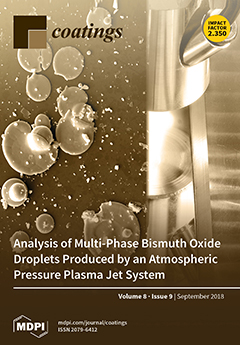Chlorophyllins are semi-synthetic porphyrins obtained from chlorophyll that—when exposed to visible light—generate radical oxygen substances with antimicrobial activity. In this work, chlorophyllins incorporated with polyethylene (PE), polyvinyl alcohol (PVOH), (hydroxypropyl)methyl cellulose (HPMC), and gelatin (G) were formulated for application as coatings in packages
[...] Read more.
Chlorophyllins are semi-synthetic porphyrins obtained from chlorophyll that—when exposed to visible light—generate radical oxygen substances with antimicrobial activity. In this work, chlorophyllins incorporated with polyethylene (PE), polyvinyl alcohol (PVOH), (hydroxypropyl)methyl cellulose (HPMC), and gelatin (G) were formulated for application as coatings in packages providing antimicrobial activity after photoactivation. First, the antimicrobial properties of two porphyrins (sodium magnesium chlorophyllin, E-140, and sodium copper chlorophyllin, E-141) were analyzed against
L. monocytogenes and
Escherichia coli. The results indicated that E-140 was more active than E-141 and that chlorophyllins were more effective against Gram-positive bacteria. In addition, both chlorophyllins were more efficient when irradiated with halogen lamps than with LEDs, and they were inactive in dark conditions. Then, coatings on polyethylene terephthalate (PET) film were prepared, and their effect against the test bacteria was similar to that shown previously with pure chlorophyllins, i.e., greater activity in films containing E-140. Among the coating matrices, those based on PE presented the least effect (1 log reduction), whereas PVOH, HPMC, and G were lethal (7 log reduction). The self-sanitizing effect of these coatings was also analyzed by contaminating the surface of the coatings and irradiating them through the PET surface, which showed high efficiency, although the activity of the coatings was limited to
L. monocytogenes. Finally, coated films were applied as separators of bologna slices. After irradiation, all the films showed count reductions of
L. monocytogenes and the usual microbial load; the gelatin coating was the most effective, with an average of 3 log reduction.
Full article





